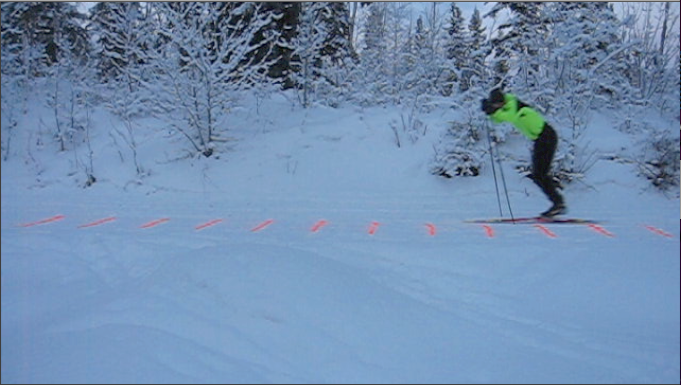After analyzing the video from my two different styles of double poling I was able to come up with a couple different numbers. First is the average speed of each run over the 40 feet I was testing on. The runs in which I tried to act like I was racing are called normal, while the the others are called experiment.
| Trial # | 1 | 2 | 3 | 4 | 5 | 6 |
|---|---|---|---|---|---|---|
| Type | Normal | Experiment | Normal | Experiment | Normal | Experiment |
| Speed (fps) | 16.9 | 15.7 | 17.4 | 16.9 | 17.8 | 17.4 |
From this table we can see that on average the Normal are faster than the Experiment. This is what I would expect from what I have experience as a skier. The smallest Experiment value was 10.7 mph while the fastest Normal was 12.2 mph. These speeds also compare well to my skiing. What I find interesting is how close the Normal and Experiment values were. From low to high there was only a 1.5 mph difference. This would be significant over any longer distance, but it is not as large a difference as I expected. More data would help clarify these values more, but I don't think the results would change that much. It makes me realize how competitive this sport is, that small differences like this can create such a large change in results.


The second number I was able to measure was the poling angle.
| Trial # | 1 | 2 | 3 | 4 | 5 | 6 |
|---|---|---|---|---|---|---|
| Type | Normal | Experiment | Normal | Experiment | Normal | Experiment |
| Angle (degrees) | 78 | 59 | 76 | 62 | 81 | 63 |
Because of human error I was unable to get a constant number for each trial. However the angles that are supposed to be the same don't vary much. Five degrees for the Normal and four degrees for the Experiment. Comparing these values to the speed there appears to be a slight correlation between the angle and speed. It seems that the larger the angle the higher the speed. With only three data points for each style there isn't enough to make any sort of conclusions. This is what I would expect, though. I believe that as the poling angle goes up the body weight of the skier comes forward as can be seen in the photos. Gravity would then be helping to increase the magnitude of the force on the poles, thus also increasing the force pushing the skier forward.
Finally, I was able to get a little information about the actual force of the double pole. Unfortunately this graph, of the Normal runs, is of little use. The sensor was damaged beyond repair before I could get data for Experiment runs. Also, I didn't have any remaining time to calibrate the force readings, so they remain in the analog values that the sensor put out. It is interesting to see how quick the force of the poling action is over. I believe that in the Experiment runs the force would have been even quicker because the poles plant farther back and so have less distance to travel.
